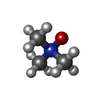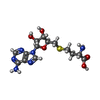+ Open data
Open data
- Basic information
Basic information
| Entry | Database: PDB / ID: 6d6y | ||||||||||||
|---|---|---|---|---|---|---|---|---|---|---|---|---|---|
| Title | AprA Methyltransferase 2 - GNAT didomain in complex with SAH | ||||||||||||
 Components Components | AprA Methyltransferase 2 | ||||||||||||
 Keywords Keywords | TRANSFERASE / methyltransferase / decarboxylase / apratoxin / GCN5 related N-acetyltransferase | ||||||||||||
| Function / homology |  Function and homology information Function and homology informationbiosynthetic process / phosphopantetheine binding / transferase activity / metal ion binding Similarity search - Function | ||||||||||||
| Biological species |  Moorea bouillonii (bacteria) Moorea bouillonii (bacteria) | ||||||||||||
| Method |  X-RAY DIFFRACTION / X-RAY DIFFRACTION /  SYNCHROTRON / SYNCHROTRON /  MOLECULAR REPLACEMENT / Resolution: 2.246 Å MOLECULAR REPLACEMENT / Resolution: 2.246 Å | ||||||||||||
 Authors Authors | Sikkema, A.P. / Smith, J.L. | ||||||||||||
| Funding support |  United States, 3items United States, 3items
| ||||||||||||
 Citation Citation |  Journal: ACS Chem Biol / Year: 2018 Journal: ACS Chem Biol / Year: 2018Title: Biosynthesis of t-Butyl in Apratoxin A: Functional Analysis and Architecture of a PKS Loading Module. Authors: Meredith A Skiba / Andrew P Sikkema / Nathan A Moss / Andrew N Lowell / Min Su / Rebecca M Sturgis / Lena Gerwick / William H Gerwick / David H Sherman / Janet L Smith /  Abstract: The unusual feature of a t-butyl group is found in several marine-derived natural products including apratoxin A, a Sec61 inhibitor produced by the cyanobacterium Moorea bouillonii PNG 5-198. Here, ...The unusual feature of a t-butyl group is found in several marine-derived natural products including apratoxin A, a Sec61 inhibitor produced by the cyanobacterium Moorea bouillonii PNG 5-198. Here, we determine that the apratoxin A t-butyl group is formed as a pivaloyl acyl carrier protein (ACP) by AprA, the polyketide synthase (PKS) loading module of the apratoxin A biosynthetic pathway. AprA contains an inactive "pseudo" GCN5-related N-acetyltransferase domain (ΨGNAT) flanked by two methyltransferase domains (MT1 and MT2) that differ distinctly in sequence. Structural, biochemical, and precursor incorporation studies reveal that MT2 catalyzes unusually coupled decarboxylation and methylation reactions to transform dimethylmalonyl-ACP, the product of MT1, to pivaloyl-ACP. Further, pivaloyl-ACP synthesis is primed by the fatty acid synthase malonyl acyltransferase (FabD), which compensates for the ΨGNAT and provides the initial acyl-transfer step to form AprA malonyl-ACP. Additionally, images of AprA from negative stain electron microscopy reveal multiple conformations that may facilitate the individual catalytic steps of the multienzyme module. | ||||||||||||
| History |
|
- Structure visualization
Structure visualization
| Structure viewer | Molecule:  Molmil Molmil Jmol/JSmol Jmol/JSmol |
|---|
- Downloads & links
Downloads & links
- Download
Download
| PDBx/mmCIF format |  6d6y.cif.gz 6d6y.cif.gz | 229.9 KB | Display |  PDBx/mmCIF format PDBx/mmCIF format |
|---|---|---|---|---|
| PDB format |  pdb6d6y.ent.gz pdb6d6y.ent.gz | 181 KB | Display |  PDB format PDB format |
| PDBx/mmJSON format |  6d6y.json.gz 6d6y.json.gz | Tree view |  PDBx/mmJSON format PDBx/mmJSON format | |
| Others |  Other downloads Other downloads |
-Validation report
| Summary document |  6d6y_validation.pdf.gz 6d6y_validation.pdf.gz | 717.2 KB | Display |  wwPDB validaton report wwPDB validaton report |
|---|---|---|---|---|
| Full document |  6d6y_full_validation.pdf.gz 6d6y_full_validation.pdf.gz | 722.3 KB | Display | |
| Data in XML |  6d6y_validation.xml.gz 6d6y_validation.xml.gz | 24 KB | Display | |
| Data in CIF |  6d6y_validation.cif.gz 6d6y_validation.cif.gz | 32.1 KB | Display | |
| Arichive directory |  https://data.pdbj.org/pub/pdb/validation_reports/d6/6d6y https://data.pdbj.org/pub/pdb/validation_reports/d6/6d6y ftp://data.pdbj.org/pub/pdb/validation_reports/d6/6d6y ftp://data.pdbj.org/pub/pdb/validation_reports/d6/6d6y | HTTPS FTP |
-Related structure data
| Related structure data |  7827C 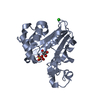 2reeS  5thyS S: Starting model for refinement C: citing same article ( |
|---|---|
| Similar structure data |
- Links
Links
- Assembly
Assembly
| Deposited unit | 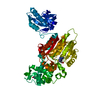
| ||||||||
|---|---|---|---|---|---|---|---|---|---|
| 1 | 
| ||||||||
| 2 |
| ||||||||
| Unit cell |
|
- Components
Components
| #1: Protein | Mass: 60130.934 Da / Num. of mol.: 1 / Fragment: GNAT didomain (UNP residues 503-1022) Source method: isolated from a genetically manipulated source Source: (gene. exp.)  Moorea bouillonii (bacteria) / Gene: BJP37_16135 / Plasmid: pMCSG7 / Production host: Moorea bouillonii (bacteria) / Gene: BJP37_16135 / Plasmid: pMCSG7 / Production host:  References: UniProt: A0A1U7N2Z8, Transferases; Transferring one-carbon groups; Methyltransferases |
|---|---|
| #2: Chemical | ChemComp-TMO / |
| #3: Chemical | ChemComp-SAH / |
| #4: Water | ChemComp-HOH / |
| Has protein modification | Y |
-Experimental details
-Experiment
| Experiment | Method:  X-RAY DIFFRACTION / Number of used crystals: 1 X-RAY DIFFRACTION / Number of used crystals: 1 |
|---|
- Sample preparation
Sample preparation
| Crystal | Density Matthews: 2.78 Å3/Da / Density % sol: 55.75 % |
|---|---|
| Crystal grow | Temperature: 293 K / Method: vapor diffusion, sitting drop / pH: 7.5 Details: 0.01-0.05 M trimethylamine N-oxide, 12-17% PEG8000, 0.12 M Tris, pH 7.5 |
-Data collection
| Diffraction | Mean temperature: 100 K | ||||||||||||||||||||||||||||||||||||||||||||||||||||||||||||||||||||||||||||||||
|---|---|---|---|---|---|---|---|---|---|---|---|---|---|---|---|---|---|---|---|---|---|---|---|---|---|---|---|---|---|---|---|---|---|---|---|---|---|---|---|---|---|---|---|---|---|---|---|---|---|---|---|---|---|---|---|---|---|---|---|---|---|---|---|---|---|---|---|---|---|---|---|---|---|---|---|---|---|---|---|---|---|
| Diffraction source | Source:  SYNCHROTRON / Site: SYNCHROTRON / Site:  APS APS  / Beamline: 23-ID-B / Wavelength: 1.0332 Å / Beamline: 23-ID-B / Wavelength: 1.0332 Å | ||||||||||||||||||||||||||||||||||||||||||||||||||||||||||||||||||||||||||||||||
| Detector | Type: DECTRIS EIGER X 16M / Detector: PIXEL / Date: Nov 9, 2016 | ||||||||||||||||||||||||||||||||||||||||||||||||||||||||||||||||||||||||||||||||
| Radiation | Monochromator: Double crystal cryo-cooled Si(111) / Protocol: SINGLE WAVELENGTH / Monochromatic (M) / Laue (L): M / Scattering type: x-ray | ||||||||||||||||||||||||||||||||||||||||||||||||||||||||||||||||||||||||||||||||
| Radiation wavelength | Wavelength: 1.0332 Å / Relative weight: 1 | ||||||||||||||||||||||||||||||||||||||||||||||||||||||||||||||||||||||||||||||||
| Reflection | Resolution: 2.246→48.861 Å / Num. obs: 60876 / % possible obs: 98.4 % / Redundancy: 6.067 % / Biso Wilson estimate: 52.96 Å2 / CC1/2: 0.998 / Rmerge(I) obs: 0.09 / Rrim(I) all: 0.099 / Χ2: 1.039 / Net I/σ(I): 12.09 | ||||||||||||||||||||||||||||||||||||||||||||||||||||||||||||||||||||||||||||||||
| Reflection shell | Diffraction-ID: 1
|
- Processing
Processing
| Software |
| |||||||||||||||||||||||||||||||||||||||||||||||||||||||||||||||||||||||||||||||||||||||||||||||||||||||||||||||||||||||||||||||||||||||||||||||||||||||||||||||||
|---|---|---|---|---|---|---|---|---|---|---|---|---|---|---|---|---|---|---|---|---|---|---|---|---|---|---|---|---|---|---|---|---|---|---|---|---|---|---|---|---|---|---|---|---|---|---|---|---|---|---|---|---|---|---|---|---|---|---|---|---|---|---|---|---|---|---|---|---|---|---|---|---|---|---|---|---|---|---|---|---|---|---|---|---|---|---|---|---|---|---|---|---|---|---|---|---|---|---|---|---|---|---|---|---|---|---|---|---|---|---|---|---|---|---|---|---|---|---|---|---|---|---|---|---|---|---|---|---|---|---|---|---|---|---|---|---|---|---|---|---|---|---|---|---|---|---|---|---|---|---|---|---|---|---|---|---|---|---|---|---|---|---|
| Refinement | Method to determine structure:  MOLECULAR REPLACEMENT MOLECULAR REPLACEMENTStarting model: PDB entry 5THY & 2REE Resolution: 2.246→48.861 Å / SU ML: 0.34 / Cross valid method: THROUGHOUT / σ(F): 1.36 / Phase error: 25.51
| |||||||||||||||||||||||||||||||||||||||||||||||||||||||||||||||||||||||||||||||||||||||||||||||||||||||||||||||||||||||||||||||||||||||||||||||||||||||||||||||||
| Solvent computation | Shrinkage radii: 0.9 Å / VDW probe radii: 1.11 Å | |||||||||||||||||||||||||||||||||||||||||||||||||||||||||||||||||||||||||||||||||||||||||||||||||||||||||||||||||||||||||||||||||||||||||||||||||||||||||||||||||
| Displacement parameters | Biso max: 179.05 Å2 / Biso mean: 68.1807 Å2 / Biso min: 29.4 Å2 | |||||||||||||||||||||||||||||||||||||||||||||||||||||||||||||||||||||||||||||||||||||||||||||||||||||||||||||||||||||||||||||||||||||||||||||||||||||||||||||||||
| Refinement step | Cycle: final / Resolution: 2.246→48.861 Å
| |||||||||||||||||||||||||||||||||||||||||||||||||||||||||||||||||||||||||||||||||||||||||||||||||||||||||||||||||||||||||||||||||||||||||||||||||||||||||||||||||
| Refine LS restraints |
| |||||||||||||||||||||||||||||||||||||||||||||||||||||||||||||||||||||||||||||||||||||||||||||||||||||||||||||||||||||||||||||||||||||||||||||||||||||||||||||||||
| LS refinement shell | Refine-ID: X-RAY DIFFRACTION / Rfactor Rfree error: 0 / Total num. of bins used: 22
|
 Movie
Movie Controller
Controller



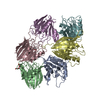
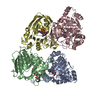
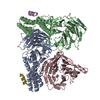

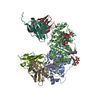

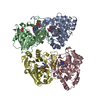
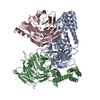
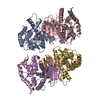

 PDBj
PDBj





